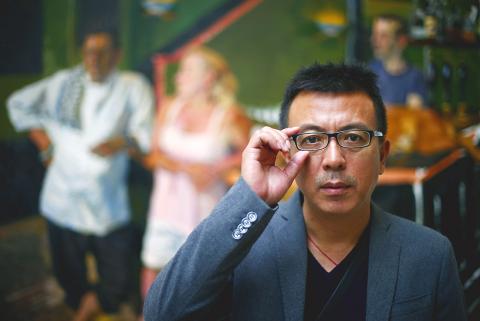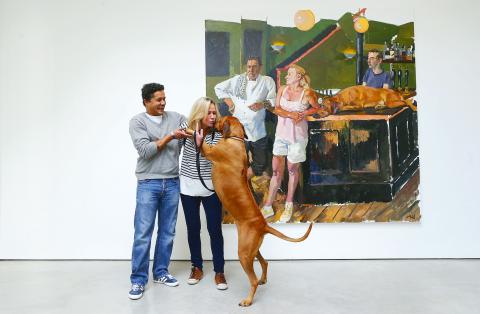One of China’s best known artists, Liu Xiaodong (劉小東), headed down to the pub for inspiration for his first London show.
The soft-spoken, bespectacled 50-year-old artist has spent the last three decades capturing the lives of ordinary people in his paintings, painted-over photographs, diaries and films from China to Europe and the Middle East.
His Half Street exhibition depicts the lives of people Liu befriended over six weeks in two pubs and an Egyptian cafe just steps from the Lisson gallery where the large oil-on-canvas paintings are displayed alongside acrylic photo-paintings.

Photo: Reuters
“It’s such an exciting thing to share with other people,” said Liu, a leading figure among Chinese Neo-Realist painters and professor at the Central Academy of Fine Arts.
Liu likes to spend time getting to know his subjects. The Beijing-based artist writes and draws in a journal and then takes photographs before building a temporary studio in situ, to paint en plein air or xiesheng (寫生) in Chinese.
It’s a technique he has used previously living and painting among local people from Tibet to Israel. Critics have compared his work to that of British painter Lucian Freud.

Photo: Reuters
“The background is important,” he told Reuters in an interview this week.
In London he was invited into the homes of the staff at The Perseverance pub, had dinner with them, smoked with them and walked their dogs.
“I very much enjoyed painting here because at first we didn’t know each other,” Liu said. “After painting we are close, we know each other and feel very good.”
Green Pub depicts The Perseverance with its staff and trusty dog Mati, painted from life over four consecutive days during opening hours.
“All our customers were all in the pub as it was taking place, so it created a really good vibe,” said the pub’s 46-year-old landlady, Margaret Finnegan, originally from New Jersey in the US.
Photographs with touches of paint from Liu add small details such as rain drops, but also figures and in one case a portrait of Finnegan’s late father painted into a photograph alongside her husband working in the kitchen.
When she saw it, Liu said: “She was almost crying ... I was crying too.”
French chef Sebastien Lambot, his Polish wife Marta, their 17-month-old son and a reveler dressed as a cowboy riding a horse are the subjects in White Pub, an oil-on-canvas painting Liu created after befriending the couple and asking permission to paint them in The Chapel pub where Sebastien works.
“When we Googled his name we found out he was a world-famous artist,” Sebastien said. “We’ve become immortal in a way.”
The final location, shown in the painting Egyptian Restaurant, is an upstairs meeting room of an eatery on the Edgware Road in London, itself a former Art Deco cinema.
It is depicted empty, with the television off and the chairs either recently vacated or waiting for new occupants.
The work was painted just after the Muslim celebration of Eid, the feast following the fasting of Ramadan.
A few steps from the door of the gallery, an image of dissident Chinese artist Ai Weiwei (艾未未) spray-painted on a wall in the style of British street artist Banksy shouts out: “You can cage the singer, but not the song.”
Liu would not be drawn on questions about Ai, who was detained without charge in April 2011 for 81 days.
“Every artist is different,” he said. “Every artist has their own background.

May 26 to June 1 When the Qing Dynasty first took control over many parts of Taiwan in 1684, it roughly continued the Kingdom of Tungning’s administrative borders (see below), setting up one prefecture and three counties. The actual area of control covered today’s Chiayi, Tainan and Kaohsiung. The administrative center was in Taiwan Prefecture, in today’s Tainan. But as Han settlement expanded and due to rebellions and other international incidents, the administrative units became more complex. By the time Taiwan became a province of the Qing in 1887, there were three prefectures, eleven counties, three subprefectures and one directly-administered prefecture, with

It’s an enormous dome of colorful glass, something between the Sistine Chapel and a Marc Chagall fresco. And yet, it’s just a subway station. Formosa Boulevard is the heart of Kaohsiung’s mass transit system. In metro terms, it’s modest: the only transfer station in a network with just two lines. But it’s a landmark nonetheless: a civic space that serves as much more than a point of transit. On a hot Sunday, the corridors and vast halls are filled with a market selling everything from second-hand clothes to toys and house decorations. It’s just one of the many events the station hosts,

Among Thailand’s Chinese Nationalist Party (KMT) villages, a certain rivalry exists between Arunothai, the largest of these villages, and Mae Salong, which is currently the most prosperous. Historically, the rivalry stems from a split in KMT military factions in the early 1960s, which divided command and opium territories after Chiang Kai-shek (蔣介石) cut off open support in 1961 due to international pressure (see part two, “The KMT opium lords of the Golden Triangle,” on May 20). But today this rivalry manifests as a different kind of split, with Arunothai leading a pro-China faction and Mae Salong staunchly aligned to Taiwan.

Two moves show Taichung Mayor Lu Shiow-yen (盧秀燕) is gunning for Chinese Nationalist Party (KMT) party chair and the 2028 presidential election. Technically, these are not yet “officially” official, but by the rules of Taiwan politics, she is now on the dance floor. Earlier this month Lu confirmed in an interview in Japan’s Nikkei that she was considering running for KMT chair. This is not new news, but according to reports from her camp she previously was still considering the case for and against running. By choosing a respected, international news outlet, she declared it to the world. While the outside world